Our Smithsonian: Janet Draper
A few hundred years ago, before the world turned upside down, the Torch interviewed horticulturist Janet Draper. We were most concerned then about the dangers of a late frost on early-blooming tree and flowers, but we have since learned that nature takes each day as it comes—as should we.
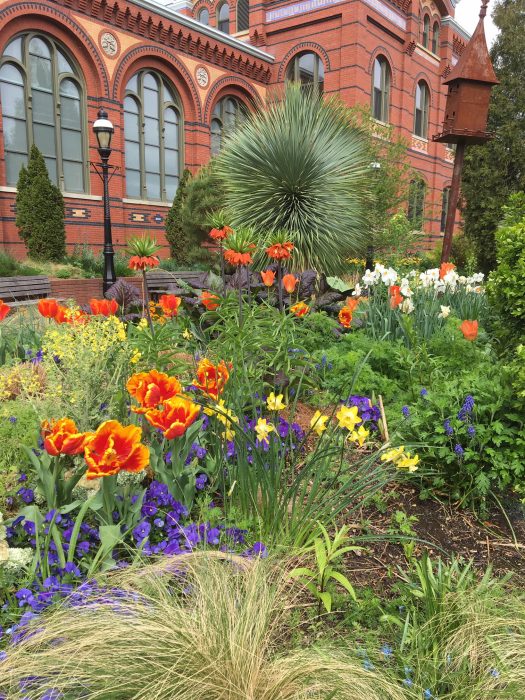
Early spring flowers in the pocket garden between the Arts and Industries Building and the Hirshhorn Museum and Sculpture Garen on the National Mall. (Photo by John Barrat)
It was a rainy day in early February when The Torch caught up with Janet Draper, horticulturist of the Mary Livingston Ripley Garden, the garden oasis on the south side of the National Mall nestled between the Arts and Industries Building and the Hirshhorn Museum. Rain was coming down, the temperature outside a balmy 52 F° (a continuation of the extremely mild winter Washington, D.C., has had) and Draper was in her office scanning catalogues for plants to order for the coming season.
Considering the warm winter weather, The Torch started the conversation by asking Janet for her thoughts regarding the premature sprouting and blooming of many of the ornamental plants in the Ripley Garden.
It’s only February, but many buds and blooms are beginning to pop on the perennials and annuals in the Ripley Garden.
Yes, they are. A lot of things seem to be a few weeks early. Right now, I’ve got many Helleborus in bloom, along with Edgeworthia and Camelias which normally bloom now, but things like Daphne, crocus and some scillas are a couple of weeks early.
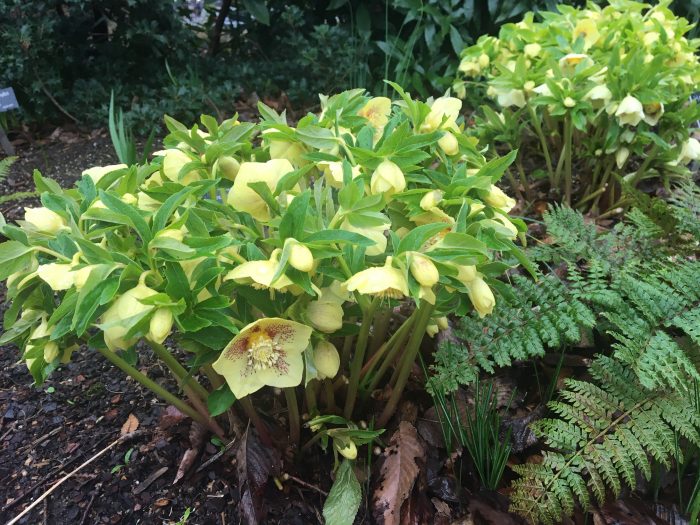
Hellebore “Pine Knot Yellow.” Photo courtesy Janet Draper.
But the main thing that I have learned over years of gardening is that plants can handle it. Don’t freak out. They are more adapted than we are.
As a gardener, one can only do so much. Should we get a killing frost or even worse, a freeze; we might lose the flowers for one season if the buds are too far expanded. It is sad for the gardener, but there is always next year!
Being in charge of such a public garden, if you lose some plants early on do you try to fill-in with a substitute later on?
Sometimes I might add in a few things just to tweak the display. But my designs always have a lot of diversity, so if one plant fails, there are others that will fill the void. You can’t control nature. Part of the joy of gardening is every year is different. You might plan for one look, and you get a totally different look by the bloom time. Plants work on their schedule, not what you have dreaming of!
How long the blossoms last depend on what the weather gives. If they are out in torrential rain and wind and snow and ice the flowers are not going to last as-long in cool, moderate and sunny weather. As a gardener you just do your best and leave the rest to Mother Nature.
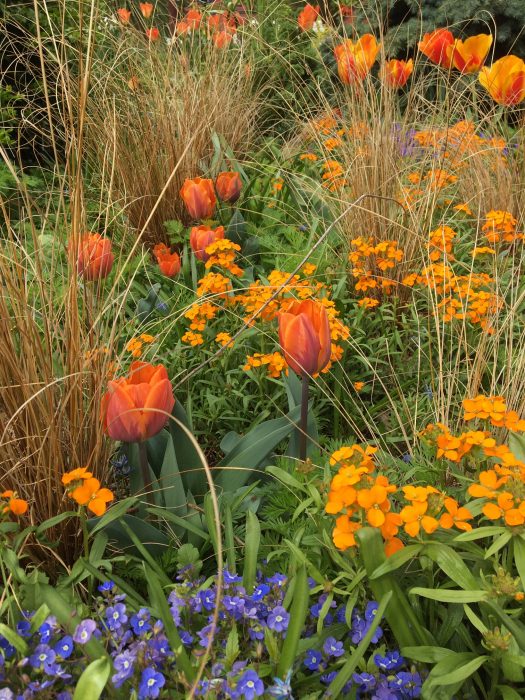
Tulip ‘Princes Irene’ with Blue Speedwell (Veronica ‘Georgia Blue’), orange wall flower (Cherianthus SUGAR RUSH Orange) and New Zealand Sedge, Carex buchananii
How does warm weather impact perennials in the Ripley Garden?
In this region, perennials are adapted to go into a dormant or rest period and when they don’t get enough cold days, they start breaking down. Just like humans can only go so long without sleep, perennials adapted to cold weather will only last so long without this rest period.
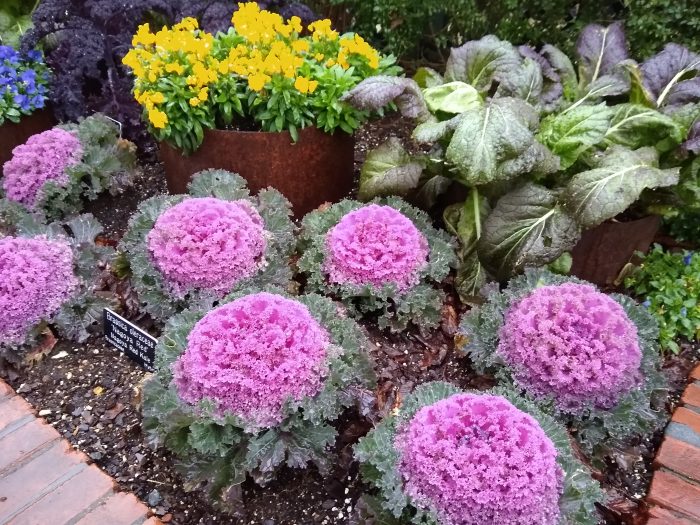
The round leafy lavender plants are Kale, behind and to left is mustard ‘Red Giant’ and Wallflower (Cherianthus Sugar Rush yellow)…
It really wasn’t intention when I planted this bed, but it is all primarily vegetables. Mustard, Kales, and even the wall flowers are edible! (Photo courtesy Janet Draper)
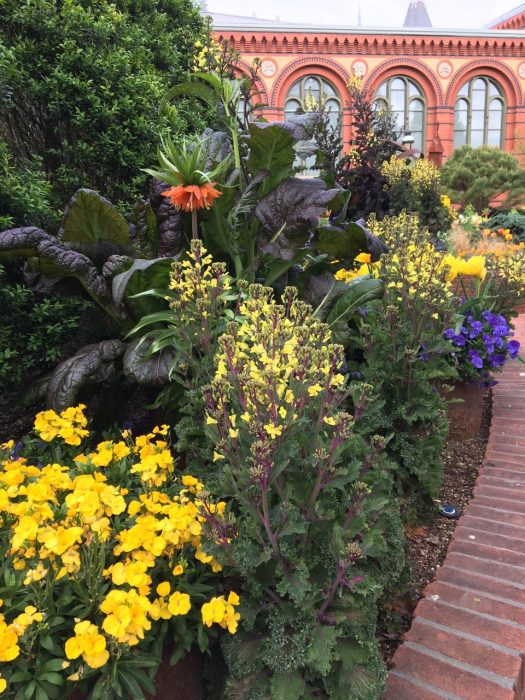
Kales in bloom with fritillarias, April 2020. (Photo courtesy Janet Draper)
What do you recommend for home gardeners reading this?
RELAX! With all this warm weather people are ready to get out and clean everything up. If anything, let me issue a gentle plea to accept a little chaos out in your garden. Don’t be so tidy. Your garden is the Home Depot for insects and birds and animals; it is where they get their building supplies for their habitat. If you’ve got to get out there and just can’t resist cleaning things up, leave a little on the ground.
For example, this is a perfect time to be cutting back ornamental grasses. Instead of taking all-of that material away, cut it up into smaller pieces and leave some on the ground. I think it is so cool when I see birds in the spring with a big beak full of materials that I’ve chopped up and left for them.
Along those same lines, don’t take away all the leaves, you might want to rake through and fluff them up a little bit or maybe even run a lawnmower over them once. But let them remain. They provide insulation so your soil won’t warm up and thaw out too quickly, plus cover for insects, which are food for the birds and other animals. Eventually old leaf material breaks down and adds nutrients to the soil. It is all part of a complex cycle that we need to respect.
Our whole thing about bagging up all of our leaves and sending them off and then buying chipped up trees to put down on the ground is crazy when you stop and think about it. We need to just relax and observe nature more.
Plants do not need to be mulched—ever! If you like the look and want to reduce weeds, and help hold in moisture, then a light mulching will do the job, but it is not necessary to do yearly. Please don’t pile mulch higher than two inches and don’t let it touch the trunk of a tree.
Why should mulch not touch a tree’s trunk?
It’s like having a cast on your arm for an extended period. In time the skin beneath degrades and becomes soft and tender. The same thing happens with mulch against the side of a tree. The bark is the barrier to keep animals and insects out. Too much mulch softens the bark and makes it easy for mice and insects to burrow in.
Deep mulch also suffocates tree roots that are seeking moisture. Instead of the roots going down deep they start coming up seeking moisture. Over mulching kills trees. If you absolutely must mulch yearly, be sure to rake away the old mulch before adding new, and NEVER higher that two inches.

Don’t do this. (Photo copyright 2018, Joe Baggs, OSU Extension.)
You maintain the Ripley Garden meticulously and with a diversity of plant species each one neatly labeled. What is your ultimate goal?
My goal has always been to show people plants they don’t know. Or maybe a plant combination that they hadn’t thought about. Using parsley as an edging material, for example, or incorporating edible plants in an ornamental garden, or during the summer with the Brazilian climbing plant Aristolochia grandiflora, just trying to get people look at a garden.
Really, I am competing with the Air and Space Museum. Frequently, a family will be walking by on their way to Air and Space and the gardener in the group will say excitedly: “Oh, a garden! Let’s go in.” What normally follows is a groan “Oh, god. No!,” from the rest of the family.
But if I can show them something cool and really funky, like the Aristolochia that looks like a piece of meat hanging there, they come in to investigate. Pretty soon they are asking: What is it? Where does it come from? and Why is it colored that way? Soon, they have forgotten about Air and Space. It’s devious, but once I get them in the garden…
The Smithsonian is all about teaching and showing and engaging and I really want to do that out in the garden, and maybe, I can inspire a non-gardener to plant something!

A whimsical sculpture welcomes visitors to the entrance to the Mary S. Ripley Garden on the National Mall.
How long have you worked in the Ripley Garden?
Twenty-three years. I’m the luckiest of the gardeners on the Mall. I really am. The Ripley Garden is such a beautiful space. I thank the Smithsonian’s Women’s Committee eternally for creating the bones of such an intimate space on the National Mall.
There’s a homeless guy on the Mall that I have talked to for the last 20 years, and a few days ago I was bemoaning the fact that it was so warm so early. He stopped me and said “Janet, every day is a blessing. Take it and enjoy it and don’t look back.”
I responded, “Oh my gosh Alex, you are so right.” So, getting advice from the homeless on the Mall is another interesting aspect of my job.
So, enjoy what presents itself because you cannot change it. Just don’t be too aggressive in cleaning everything up.
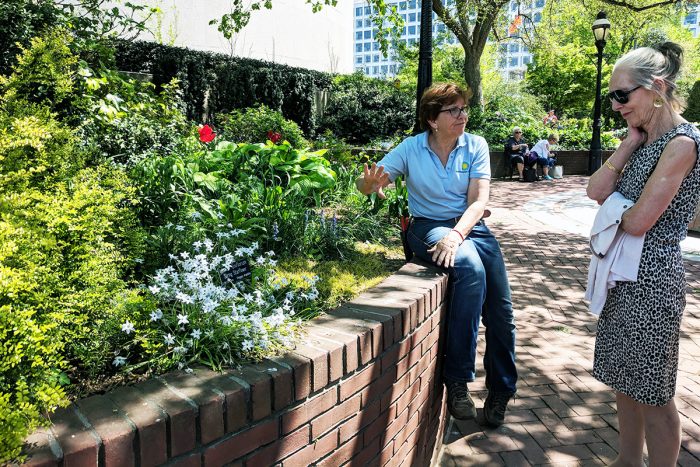
Janet Draper (left) is always ready to chat with visitors about plants she selects for the Ripley Garden. (2018 photo by Betty Belanus)
April 13 Lockdown Update
I hope you are well and staying safe and engaged during this challenging time.
We have ab absolute skeleton crew rotating through who are allowed to be on site in our gardens and greenhouses. I’m not scheduled for another couple of weeks. Our focus right now is just to keep things alive in our downtown gardens—we’re not doing any new plantings.
It is soooo hard for me to stay away from the garden downtown. (Aren’t I lucky to have a job I so love?). Spring is what gardeners work for, and now is the time when those ‘dreams’ we installed last fall come to life.
In the fall we planted brown bulbs with the dream that the choices we made were the right ones to play off of the existing plantings and excite and delight the visitors. Now is the time those dreams show themselves. It’s very hard not to be there to see them. But we’re so fortunate that Smithsonian leadership is looking out for us.
The gardens are still being shared through social media and bringing joy and belief in tomorrow to people from around the globe. We are all in this together and our gardens can lighten the tremendous burden (and boredom) for those doing the right thing and staying home.
Stay well,
Janet
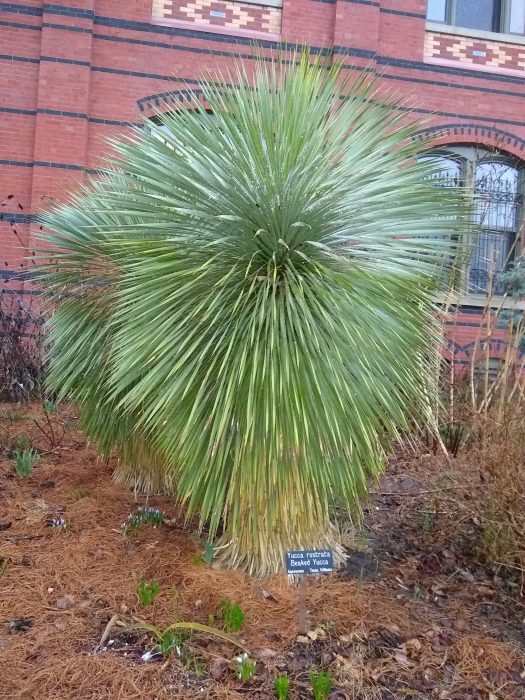
Yucca rostrata is a show-stopper even in late winter. (Photo courtesy John Barrat)
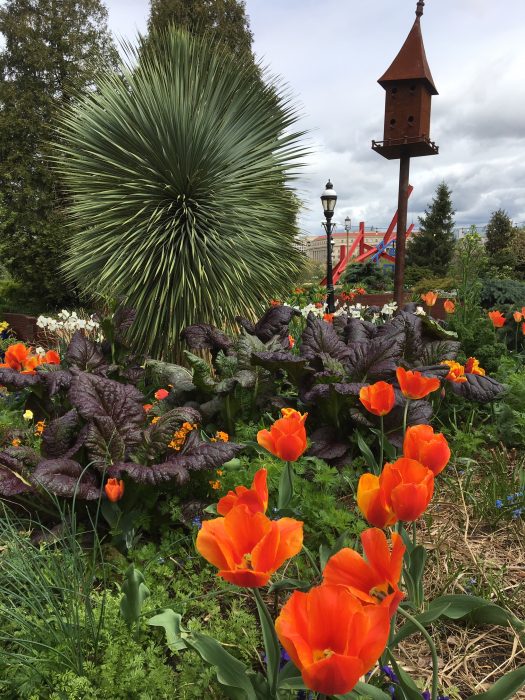
Yucca rostrata holding court with tulips and mustard greens in attendance, April 2020. (Photo courtesy Janet Draper)
Posted: 13 April 2020
- Categories:







